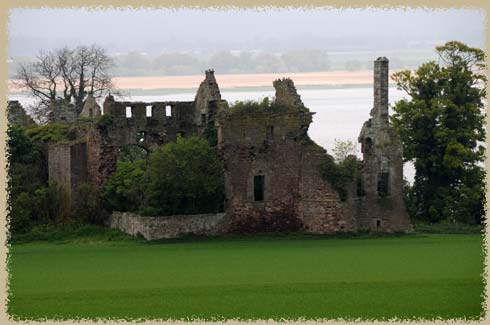Ballinbreich Castle
We came upon this castle from the farm side, and stopped to take a few quick pictures. It is apparently accessible on foot from the road long the firth, but we didn't go down to the water. It was far too wet to slog through the fields, in any case. Access via a small road appears to be avaialble a bit further down, but the ruin is on private property, so ask permission before you try to access it.

from the road, with the first of tay in the background
14th century L-plan tower
This is a surprisingly large ruin, of a 15th century courtyard castle. A curtain wall about 2m thick surrounded the entire castle, but most of it has fallen. The main part of the castle is a large L-plan tower house with a stair in the angle of the tower. THe current entrance to the castle is in the round tower, and much of the curtain wall has been reduced to a small, modern courtyard wall. The courtyard was roughly rectangular (180' x 70'), but with the northerly corner angled off. An early reference suggests it was surrounded by a moat, which has obviously been subsumed into the field that now surrounds the castle.
The main block has vaulted cellars, and the second story of the hall has a chapel, with the piscina still intact (the font for holy water). The side of the castle facing the water has mostly fallen, leaving only a doorway. This range would have been livigng quarters over a basement.
The second story included the chapel and had large, east-facing windows. As the castle was modernized, it was combined with the third story to make a large, impressive vaulted chamber. Most of the original main block is four storys high.
There is a nameplate and initials on the entrance way, dating from 1572 that suggests that it was Alexander, Earl of Rothes who remodeled the castle and is responsible for most of the extensions and additioanl building ranges. The southeast range was added at that point, and the round tower and new entrance were added. A new north range was built to replace the original, which had disappeared (probably fell into the sea -- they tend to do that after awhile...a good rule of thumb: if staying in a medieval castle, do not stay in the rooms ont he cliff-side, no matter how nice the view!). The new buildings are easy to distinguish from the earlier ones, being of fine faced ashlar stones.
Even later, a two-story additiona on the south side of the eastern court were added. These are mostly gone. A survey of the faint shadows still visible in the field show outlines of further outbduildings and medieval structures when the Council of Scottish Archaeology evaluated the field.
Ownership
In 1160, the site here on the southern shore of the FIrth was owned by the Abernethy family (they took the name about 1200). When Andrew Abernethy died in 1312, the lands were divided between his two daughters. Mary married into the Leslie family, who adopted their arms from Abernethy. According to the Clan history pages, the coat of arms of the Abernethy family is still incorproated into the Leslie coat of arms, and the battle cry of the clan is "Ballinbreich!'.
The land here originally belonged to the Leslie family. It was acquired in 1312 and they erected a castle on the site soon after. Much of the original work was rebuilt in the 16th century by Alexander.

close-up of the short modern wall in the courtyard
The family became the Earls of Ross in 1457, and many of the early Earls were killed off in rather spectacular fashion (including poisoning in France). Mary, Queen of Scot visited the castle in 1555.
The Earls were elevated to Dukes of Rothes in 1680, but when the first Duke, John, died without an heir, the title died with him. THe family reverted to the title Earl and continued through other lines of descent until the property was sold to the Dundases of Kerse in the 19th century. They were designated the Earls of Shetland in 1838 and athen Marquises in 1873. The prominence of the families owning the castle is surprising, since it doesn't appear to be a particularly powerful castle, nor does it hold a strong position.

